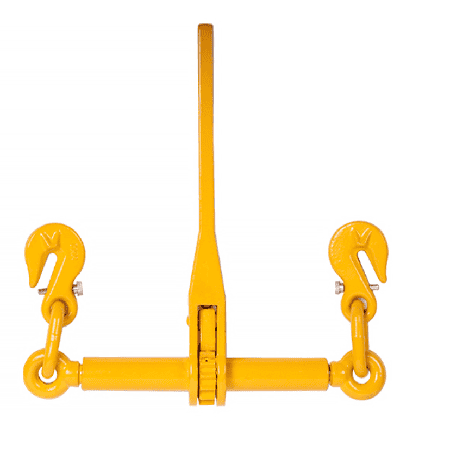What Is a Container Twist Lock? Types, Advantages & Selection Tips
With global trade growing rapidly, sea and land transport have become essential for cargo movement. And when it comes to container transportation, a small yet powerful device—the container twist lock—plays a key role in securing your cargo safely.
What Is a Twist Lock?

A twist lock is a mechanical locking device used to secure containers during transportation. It’s widely used on ship decks, truck chassis, and in container yards to prevent shifting, tilting, or falling during transit. By inserting the twist lock into the container’s corner casting and rotating the locking head, the container is safely locked in place—making it an essential part of intermodal shipping.
Common Types of Twist Locks
The most commonly used container twist locks can be divided into three categories: manual twist locks, semi-automatic twist locks and full-automatic twist locks.

1. Manual Twist Lock
✅ Advantages:
- Simple & Reliable: Straightforward design with easy operation; fewer mechanical issues.
- Cost-Effective: Lower cost compared to other types, ideal for budget-conscious buyers.
- Wide Application: Commonly used for standard container locking tasks.
⚠️ Disadvantages:
- Lower Efficiency: Requires manual operation for both locking and unlocking, which can be time-consuming.
- Safety Risk: Relies on manual judgment to confirm if the lock is fully engaged, increasing the chance of human error.
2. Semi-Automatic Twist Lock
✅ Advantages:
- Improved Efficiency: Partial automation reduces the need for manual handling, speeding up the locking/unlocking process.
- Enhanced Safety: More reliable than manual locks, with a more consistent locking mechanism.
- Versatile Use: Performs well in fast-paced environments like ports and container yards.
⚠️ Disadvantages:
- Higher Cost: More expensive than manual twist locks.
- Complex Maintenance: The mechanical parts are more intricate, requiring more effort and technical skill for repairs.
3. Fully Automatic Twist Lock
✅ Advantages:
- Maximum Efficiency: Fully automated operation eliminates the need for manual intervention, making it ideal for high-throughput environments.
- Top-Level Safety: Ensures precise locking and unlocking through an automated control system.
- Minimizes Human Error: Removes the need for manual confirmation, significantly reducing the risk of mistakes.
⚠️ Disadvantages:
- High Price Point: The most expensive option, best suited for operations that demand peak performance.
- Costly Maintenance: Requires regular servicing and advanced technical support.
- Skilled Operation Required: Needs trained personnel for installation and maintenance.
🧭 Summary: Which Twist Lock Should You Choose?
| Twist Lock Type | Best For | Budget | Efficiency | Safety |
|---|---|---|---|---|
| Manual | Basic operations with a limited budget | ★★★★☆ | ★★☆☆☆ | ★★☆☆☆ |
| Semi-Automatic | Balanced performance and moderate cost | ★★★☆☆ | ★★★★☆ | ★★★★☆ |
| Fully Automatic | High-demand environments like modern ports | ★☆☆☆☆ | ★★★★★ | ★★★★★ |
Final Tip:
- Choose manual twist locks if cost is your top concern and operations are relatively simple.
- Choose semi-automatic for a balance between speed, safety, and budget.
- Choose fully automatic for maximum safety, automation, and efficiency—ideal for busy logistics hubs and modern container terminals.
Technical Specifications of Container Twist Locks
| Parameter | Manual twist lock | Semi-automatic twist lock | Full-automatic twist lock |
| Rated Tensile Load | 500KN-520KN | 500KN-520KN | 500KN-52-KN |
| Working Load Limit | 250KN-260KN | 250KN-260KN | 250KN-260KN |
| Twist Angle | 90° manual rotation | Automatic 90° upon stacking | Automatic 90° upon stacking |
| Installation Method | Manually inserted and rotated | Pre-inserted before lifting | Pre-installed on the lower container |
| Unlocking Method | Manual with handle/Wrench | Manual pull ring/lever | Fully automatic during lifting |
| Lock Engagement Indicator | None/Visual | Mechanical indicator(Red/Green) | System-embedded |
| Corrosion Protection | Hot-dip galvanized | Hot-dip galvanized | Hot-dip galvanized |
| Typical Applications | Truck chassis, yard storage | Port terminals | Fully automated terminals cranes |
How to operate these twist locks?
1. Manual Twist Lock
Operation Steps:
- Insert the twist lock into the corner casting.
- Manually rotate the lock head 90° using a handle or wrench.
- Check to confirm the lock is fully engaged.
- To unlock, manually rotate back and remove the lock.
✅ Pros:
- Simple structure
- Easy to operate
- Low cost
⚠️ Cons:
- Time-consuming
- Relies on manual confirmation
- Higher risk of human error
2. Semi-Automatic Twist Lock
Operation Steps:
- Pre-insert the lock into the lower container’s corner casting (unlocked state).
- When the upper container is stacked, pressure triggers automatic locking.
- Check locking status via indicator or visual inspection.
- To unlock, manually pull the handle or lever.
✅ Pros:
- Faster operation
- More reliable locking
- Ideal for port operations
⚠️ Cons:
- Higher cost than manual type
- Requires periodic maintenance
3. Fully Automatic Twist Lock
Operation Steps:
- Lock is pre-installed on the lower container.
- When containers are stacked, the lock engages automatically by gravity or pressure.
- No manual confirmation is needed.
- When lifted, the lock automatically disengages.
✅ Pros:
- Fully automated
- Highest efficiency
- Maximized safety
⚠️ Cons:
- High cost
- Requires technical setup and maintenance
🔍 Quick Comparison
| Type | Locking | Unlocking | Manual Involvement | Efficiency |
|---|---|---|---|---|
| Manual Twist Lock | Manual | Manual | ✅ Required | ⭐⭐ |
| Semi-Auto Twist Lock | Auto (on stack) | Manual | ✅ Partial | ⭐⭐⭐⭐ |
| Fully Auto Twist Lock | Fully automatic | Fully automatic | ❌ None | ⭐⭐⭐⭐⭐ |
Conclusion
Whether you’re operating a busy port terminal, a logistics hub, or simply need secure container locking on trucks or chassis, selecting the right type of twist lock—manual, semi-automatic, or fully automatic—can significantly impact your efficiency, safety, and long-term costs.


